View in other NatureServe Network Field Guides
NatureServe
Montana
Utah
Wyoming
Idaho
Wisconsin
British Columbia
South Carolina
Yukon
California
New York
A Freshwater Sponge - Ephydatia cooperensis
State Rank Reason (see State Rank above)
This Freshwater Sponge is currently ranked a "S1S3" Species of Concern in MT and is at risk because of very limited and/or potentially declining population numbers, range and/or habitat, making it vulnerable to extirpation in the state. Known from a few locations in lakes of northwest Montana.
General Description
Originally placed in a new genus Clypeatula (Peterson and Addis 2000), since moved to Ephydatia based on additional DNA analyses (Addis and Peterson 2005).
[From Peterson and Addis 2000; also reported as "unidentified sponge" in Barton and Addis 1997] Encrusting in the form of a flattened disc 12.9-30.1 mm diameter and 2.3-5.7 mm in height; light-yellow to light-tan in summer, sometimes light gray-green in winter. Oscula usually not conspicuous. Skeleton reticulate, comprised of tracts of parallel spicules, arranged in bundles and held together with small amounts of spongin; radially oriented tracts usually with 2-5 spicules and extending obliquely towards surface of sponge from base, interconnected with single spicule or bundles of 2-4 spicules to form polygonal meshwork. Megascleres (spicules) average 305.9 micrometers (=305.9 microns) in length and 23.6 micrometers in diameter; usually covered with short, conical spines (sparse or absent at tips), sometimes arranged as rosettes, with a slight midregion bulb. Subdermal cavity prominent, eurypylous choanocyte chambers opening into excurrent canals; choanocyte chamber average 30.9 micrometers diameter (lost during winter with enlargement of canals).
Phenology
Present throughout the year; sperm, eggs, and embryos present in late June, overwinters in regressed state (= non-gemmulating) in which choanocyte chambers are reduced in number or lost accompanied by enlargement of excurrent canals (Peterson and Addis 2000).
Diagnostic Characteristics
Light tan in summer, sometimes light gray-green in winter; a hard, disc-shaped encrustation to 30 mm diameter on the undersides of rocks and logs; gemmules and microscleres absent; amphioxeal megascleres often with a slight midregion bulb and usually covered with short, conical spines except at their tips; overwinters in a regressed state in which choanocyte chambers are reduced in number or absent, accompanied by enlargement of excurrent canals (Barton and Addis 1997, Peterson and Addis 2000).
Species Range
Montana Range
Range Descriptions
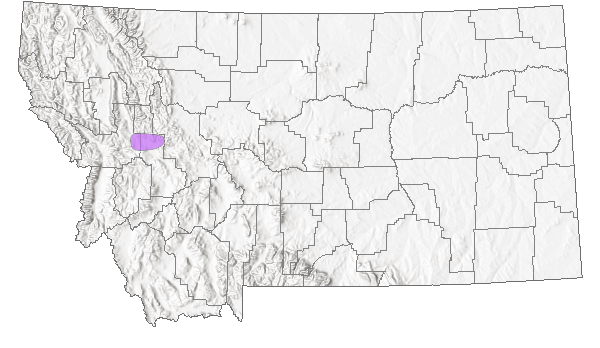
 Native
Native
Range Comments
Montana endemic: currently known from three lakes within the Clearwater and Blackfoot River systems in Missoula and Powell counties, at 1170 m to 1369 m elevation (Barton and Addis 1997; Peterson and Addis 2000). Range extensions farther into the Seeley/Clearwater Natural Lake chain and over into the Swan River Natural Lakes areas are highly probable (Addis personal communication 2007).
Observations in Montana Natural Heritage Program Database
Number of Observations: 4
(Click on the following maps and charts to see full sized version)
Map Help and Descriptions
Relative Density
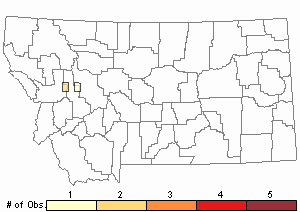
Recency
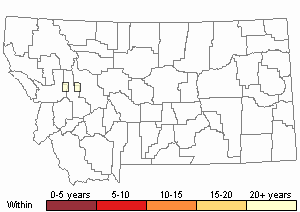
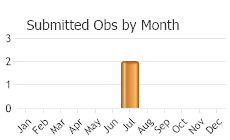
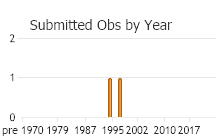
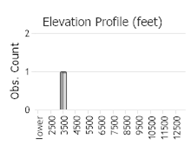 (Observations spanning multiple months or years are excluded from time charts)
(Observations spanning multiple months or years are excluded from time charts)
Migration
Non-migratory
Habitat
Occurs on the undersides rocks and logs in cool western Montana natural lakes at depths ranging from 37-80 cm (Peterson and Addis 2000).
Food Habits
Specific diet not described. Filter feed on particles or organisms such as algae, diatoms, other microorganisms.
Reproductive Characteristics
Gonochoristic or successively hermaphroditic, with oogenesis and spermatogenesis occurring in separate sponges once per year. Sperm, eggs, and embryos present in specimens collected 30 June 1998, larvae not observed (Peterson and Addis 2000).
Management
Ephydatia cooperensis is only known from three natural lakes in one basin of Montana. It has no USFWS status at the present time, although it is currently a US Forest Service Species of Concern (SOC) G1G3 and listed S1S3 in Montana. These rankings were largely due to the lack of localities reported for this species. With additional targeted survey work in the Seeley/Swan Natural Lakes area, we feel confident that more occurrences will be discovered and the rank of this species may be downgraded to at least a G3 and an S3 for the state of Montana.
Stewardship Responsibility
Threats or Limiting Factors
Specific threats to populations of Ephydatia cooperensis have not been identified. Although, excessive recreational pressures (i.e. heavy boat traffic, wading, unauthorized boat docking, etc.) may directly affect the sponge’s ability to propagate, and live in its shallow water habitats. Water quality degradation and alteration of lentic, littoral aquatic habitat by lakefront building or docks, may be a long-term concern for these populations.
References
- Literature Cited AboveLegend:
 View Online Publication
View Online Publication Barton, S.H. and J.S. Addis. 1997. Freshwater sponges (Porifer: Spongillidae) of western Montana. Great Basin Naturalist 57(2):93-103.
Barton, S.H. and J.S. Addis. 1997. Freshwater sponges (Porifer: Spongillidae) of western Montana. Great Basin Naturalist 57(2):93-103. Peterson, K.J. and J.S. Addis. 2000. Clypeatula cooperensis gen. n., sp. n., a freshwater sponge (Porifera, Spongilidae) from the Rocky Mountains of Montana, USA. Zoologica Scripta 29: 265-274.
Peterson, K.J. and J.S. Addis. 2000. Clypeatula cooperensis gen. n., sp. n., a freshwater sponge (Porifera, Spongilidae) from the Rocky Mountains of Montana, USA. Zoologica Scripta 29: 265-274.
- Additional ReferencesLegend:
 View Online Publication
View Online Publication
Do you know of a citation we're missing? Addis, J.S. and K.J. Peterson. 2005. Phylogenetic relationships of freshwater sponges (Porifera, Spongillina) inferred from analyses of 18S rDNA, COI mtDNA, and ITS2 rDNA sequences. Zoologica Scripta 34(6): 549-557.
Addis, J.S. and K.J. Peterson. 2005. Phylogenetic relationships of freshwater sponges (Porifera, Spongillina) inferred from analyses of 18S rDNA, COI mtDNA, and ITS2 rDNA sequences. Zoologica Scripta 34(6): 549-557.
- Web Search Engines for Articles on "A Freshwater Sponge"
- Additional Sources of Information Related to "Sponges"





